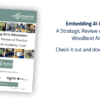
Originally shared on LinkedIn, this post focuses on ways that we can use technology, particularly iPad, although the resources can be pivoted for classrooms with all types of hardware, from Chromebooks to laptops, to MacBooks, focuses on the idea that “What’s essential for some, can be useful for all.”
When it comes to accessibility and inclusion, this phrase sits at the heart of Universal Design for Learning (UDL).
Over the past few weeks, I’ve been working with schools and sharing resources on practical ways to embed UDL into the classroom. Whether addressing accessibility for those with visual impairments, supporting focus for learners with additional needs, or offering alternative ways for students to demonstrate understanding, UDL isn’t about one-off fixes, it’s about thoughtful design that benefits everyone.
In 1:1 iPad classrooms, the tools are already there. The challenge? Knowing how to apply them effectively.
Framed around my 13+ years of experience successfully supporting students and teachers with their use of iPad, I’ve created a resource: ‘Accessibility and Inclusion in Action: Ten scenarios explored to promote UDL and inclusivity in an iPad classroom.’
I’ve tried to explore real classroom challenges and give practical, evidence-informed solutions so that you can apply them in your classroom right away.
✅ Struggling with dense reading passages? Try visual summaries.
✅ Learners missing verbal instructions? Use live captions or transcripts.
✅ Students finding handwriting hard? Dictation tools can bridge the gap.
Take a look at the resource and let me know what you think? I’d love to learn how are you approaching accessibility and inclusion in your classroom – the network, after all, is more powerful than the node.
 Which of these strategies could make the biggest impact on your learners? I recognise that these solutions won’t work in all scenarios, so how do you make this work in your setting? Share ideas back in the comments to help make learning work for everyone!
Which of these strategies could make the biggest impact on your learners? I recognise that these solutions won’t work in all scenarios, so how do you make this work in your setting? Share ideas back in the comments to help make learning work for everyone!
If you’d like a higher-resolution version of this graphic as a PDF, you can grab a copy here.














